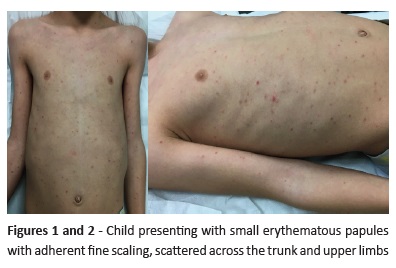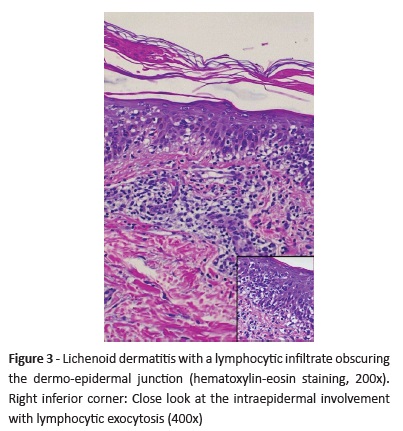Serviços Personalizados
Journal
Artigo
Indicadores
-
 Citado por SciELO
Citado por SciELO -
 Acessos
Acessos
Links relacionados
-
 Similares em
SciELO
Similares em
SciELO
Compartilhar
Nascer e Crescer
versão impressa ISSN 0872-0754versão On-line ISSN 2183-9417
Nascer e Crescer vol.28 no.3 Porto set. 2019
https://doi.org/10.25753/BirthGrowthMJ.v28.i3.15098
WHAT IS YOUR DIAGNOSIS? | QUAL O SEU DIAGNÓSTICO?
Dermatology clinical case
Caso clínico dermatológico
Francisco GilI, João AranhaI, Maria João SilvaI, Isabel AndradeII
I - Dermatology Department, Hospital Distrital de Santarém. 2005-177 Santarém, Portugal. franciscosgil@gmail.com; joaoaranha.joaoaranha@gmail.com; mariajoaoderma@gmail.com
II - Anatomic Pathology Department, Hospital Distrital de Santarém. 2005-177 Santarém, Portugal. misabel.andrade@hds.min-saude.pt
Endereço para correspondência | Dirección para correspondencia | Correspondence
ABSTRACT
Here in is reported the case of a child observed due to disseminated papulosquamous eruption, subsequently diagnosed as pityriasis lichenoides et varioliformis acuta. It is an uncommon dermatosis of unclear etiology, presenting as recurrent crops of scattered erythematous and violaceous maculopapules. Several therapeutic options have been proposed. Although clinical course is typically benign, continued monitoring is recommended.
Keywords: diagnosis; pityriasis lichenoides; treatment
RESUMO
É descrito o caso de uma criança observada devido a uma erupção papuloescamosa disseminada, subsequentemente diagnosticada como pitiríase liquenóide aguda. Trata-se de uma dermatose incomum, de etiologia ainda não totalmente esclarecida, que se manifesta por surtos recorrentes de máculas e pápulas eritemato-violáceas dispersas. Diversas opções terapêuticas têm sido propostas. Embora de evolução geralmente benigna, é recomendada vigilância clínica regular.
Palavras-chave: diagnóstico; pitiríase liquenoide; tratamento
A previously healthy nine-year-old male presented with a two-week history of disseminated asymptomatic dermatosis with numerous small erythematous fine-scaling papules on the trunk and limbs, with no apparent trigger (Figures 1 and 2). Examination was otherwise unremarkable. Histopathological exam revealed interface dermatitis with moderate-to-intense perivascular and periadnexal lymphocytic infiltrate, with epidermal exocytosis, obscuring the dermo-epidermal junction (Figure 3).
What is your diagnosis?
Diagnosis
Pityriasis lichenoides et varioliformis acuta
Discussion
In the present clinical case, diagnosis of pityriasis lichenoides et varioliformis acuta was established based on clinicopathological correlation. Topical methylprednisolone aceponate was prescribed, with marked improvement. Sporadic new lesion crops developed, milder than at initial presentation and with prompt response to topical corticosteroid therapy. At six months, the patient presented post-inflammatory hypopigmented macules.
Pityriasis lichenoides (PL) is an uncommon papulosquamous eruption with acute (pityriasis lichenoides et varioliformis acuta [PLEVA]) and chronic (pityriasis lichenoides chronica [PLC]) presentation forms.1,2 Approximately 20% of cases are reported in children.2 Etiology is uncertain, with hypotheses of an inflammatory response to an infectious agent or other antigenic trigger, a lymphoproliferative disorder, or an immune complex-mediated reaction advocated.1-3 PLEVA most commonly presents as recurrent crops of small erythematous maculopapules on the trunk and extremities.2 Diagnosis is clinically and histopathologically established, with histopathology varying according to disease phase.3 Topical corticosteroids, oral erythromycin, phototherapy, topical calcineurin inhibitors, and systemic immunosuppressants are therapeutic options.1-3 Although PL usually follows a benign course, continued monitoring of these patients is recommended, even in those with spontaneous remission.2
Lessons from this clinical case
PL comprises a spectrum of papulosquamous dermatoses of unclear etiology, with acute and chronic forms.
Diagnosis relies on the combination of characteristic clinical and histopathological features.
Topical corticosteroids are effective and well tolerated as first-line therapy.
REFERENCES
1. Skinner R, Levy A. Rapid resolution of pityriasis lichenoides et varioliformis acuta with azithromycin. Am Acad Dermatol 2008; 58:524-5. [ Links ]
2. Geller L, Antonov N, Lauren C, Morel K, Garzon M. Pityriasis Lichenoides in Childhood: Review of Clinical Presentation and Treatment Options. Pediatr Dermatol 2015; 32:579-92. [ Links ]
3. Castro B, Meyer R, Pedrosa M, Pereira J, Trindade F, Piancastelli A. Pityriasis lichenoides et varioliformis acuta after influenza vaccine. An Bras Dermatol 2015; 90:181-4. [ Links ]
Endereço para correspondência | Dirección para correspondencia | Correspondence
Francisco Gil
Dermatology Department
Hospital Distrital de Santarém
Av. Bernardo Santareno
2005-177 Santarém
Email: franciscosgil@gmail.com
Received for publication: 25.09.2018
Accepted in revised form: 14.05.2019
















